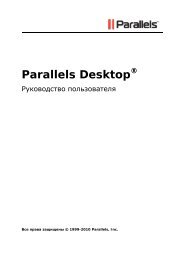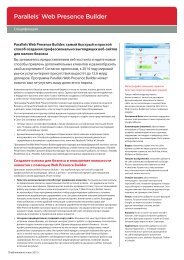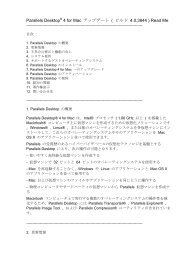[PDF] Parallels Server 5 Bare Metal
[PDF] Parallels Server 5 Bare Metal
[PDF] Parallels Server 5 Bare Metal
Create successful ePaper yourself
Turn your PDF publications into a flip-book with our unique Google optimized e-Paper software.
Customizing Container Reinstallation<br />
Managing Virtual Machines and Containers<br />
The default reinstallation, as performed by the pctl reinstall command, creates a new private<br />
area for the broken Container as if it were created by the pctl create command and copies the<br />
private area of the broken Container to the /old directory in the new private area so that no file is<br />
lost. There is also a possibility of deleting the old private area altogether without copying or<br />
mounting it inside the new private area, which is done by means of the --skipbackup option.<br />
This way of reinstalling corrupted Containers might in certain cases not correspond exactly to your<br />
particular needs. It happens when you are accustomed to creating new Containers in some other<br />
way than just using the pctl create command. For example, you may install additional software<br />
licenses into new Containers, or anything else. In this case you would naturally like to perform<br />
reinstallation in such a way so that the broken Container is reverted to its original state as<br />
determined by you, and not by the default behavior of the pctl create command.<br />
To customize reinstallation, you should write your own scripts determining what should be done<br />
with the Container when it is being reinstalled, and what should be configured inside the Container<br />
after it has been reinstalled. These scripts should be named vps.reinstall and<br />
vps.configure, respectively, and should be located in the /etc/vz/conf directory on the<br />
server. To facilitate your task of creating customized scripts, the Containers software is shipped<br />
with sample scripts that you may use as the basis of your own scripts.<br />
When the pctl reinstall command is called, it searches for the vps.reinstall<br />
and vps.configure scripts and launches them consecutively. When the vps.reinstall<br />
script is launched, the following parameters are passed to it:<br />
--veid The ID of the Container.<br />
--ve_private_tmp The path to the Container temporary private area. This path designates where<br />
a new private area is temporarily created for the Container. If the script runs<br />
successfully, this private area is mounted to the path of the original private area<br />
after the script has finished.<br />
--ve_private The path to the Container original private area.<br />
You may use these parameters within your vps.reinstall script.<br />
If the vps.reinstall script finishes successfully, the Container is started, and the<br />
vps.configure script is called. At this moment the old private area is mounted to the /old<br />
directory inside the new one irrespective of the --skipbackup option. This is done in order to let<br />
you use the necessary files from the old private area in your script, which is to be run inside the<br />
running Container. For example, you might want to copy some files from there to regular Container<br />
directories.<br />
After the vps.configure script finishes, the old private area is either dismounted and deleted or<br />
remains mounted depending on whether the --skipbackup option was provided.<br />
If you do not want to run these reinstallation scripts and want to stick to the default pctl<br />
reinstall behavior, you may do either of the following:<br />
79


![[PDF] Parallels Server 5 Bare Metal](https://img.yumpu.com/18850617/79/500x640/pdf-parallels-server-5-bare-metal.jpg)
![[PDF] Parallels Desktop® 7](https://img.yumpu.com/18852044/1/190x245/pdf-parallels-desktopr-7.jpg?quality=85)

![[PDF] Parallels Python API Reference](https://img.yumpu.com/18850615/1/190x245/pdf-parallels-python-api-reference.jpg?quality=85)








![[PDF] Parallels Python API Reference](https://img.yumpu.com/18850529/1/190x245/pdf-parallels-python-api-reference.jpg?quality=85)

